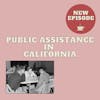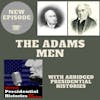Public Assistance in California (Request)

I am back with another listener request!
Longtime listener Arthur asked that I talk about the history of public assistance in the United States. Tune in this week to learn why that is quite the ask and why I decided to focus on the history of welfare in California instead.
SOURCES:
Gordon, L. & Batlan, F. “Aid to Dependent Children: The Legal History.” Social Welfare Project. 2011. (LINK)
Hajo, Cathy Moran. “Did She Really Say That? Jane Addams Quotes on the Web.” November 3, 2015. The Jane Addams Papers Project. (LINK)
“Social Work History.” National Association of Social Workers. (LINK)
Theda Skocpol, Marjorie Abend-Wein, Christopher Howard and Susan Goodrich Lehman, 35
“Women’s Associations and the Enactment of Mothers’ Pensions in the United States,” The
American Political Science Review 87, no. 3 (September 1993), 698, https://www.jstor.org/
stable/2938744.
Mark H. Leff, “Consensus for Reform: The Mothers’ Pension Movement in the Progressive
Era,” Social Service Review 47, no. 3 (September 1973), 398, ︎https://www.jstor.org/stable/
30021515.
Frances Cahn and Valeska Bary, Welfare Activities of Federal, State, and Local Governments
in California, 1850-1934, (Berkeley: University of California Press, 1936),
Gloria Ricci Lothrop, “Strength Made Stronger: The Role of Women in Southern California 18
Philanthropy” Southern California Quarterly 71, no. 2/3 (Summer/Fall 1989), 149, https://
www.jstor.org/stable/41171441.
Kristine Ashton Gunnell, “Women’s Work: The Daughters of Charity Orphans’ Fairs and the 17
Formation of the Los Angeles Community, 1858-1880,” Southern California Quarterly 93, no. 4
(Winter 2011-2012), 373-374, https://www.jstor.org/stable/41328535.
James Leiby, “State Welfare Administration in California, 1879-1929,” Pacific Historic
Review, 41, no. 2, (May, 1972), 171, https://www.jstor.org/stable/3638326.
Calif. Const. Of 1879, § 22, 1879. https://archives.cdn.sos.ca.gov/collections/1879/archive/1879-constitution.pdf
Welcome to Civics and Coffee. My name is Alycia and I am a self-professed history nerd. Each week, I am going to chat about a topic on U.S history and give you both the highlights and occasionally break down some of the complexities in history; and share stories you may not remember learning in high school. All in the time it takes to enjoy a cup of coffee.
INTRO MUSIC
Hey everyone. Welcome back.
A few months ago I received a listener request from Arthur to cover the history of public assistance in the United States. In a strange case of kismet, my upcoming master’s thesis focuses on public assistance in California. In fact, I am getting ready to defend my thesis on the 15th of March so if you listen to this before then - I am gladly accepting well wishes.
I imagine when considering the topic of public assistance, many likely think of the slew of public programs established in the aftermath of the Great Depression. Or perhaps you think of President Clinton’s vow to end welfare as we know it in the mid-90s. The truth is, assisting the poor has a long, complicated, nuanced history. As I will get into here shortly, the structure and distribution of aid programs varies across the country and therefore is hard to cover in a single episode.
For that reason, I decided to limit the scope of this episode. While public assistance can include everything from Medicaid to SNAP and is administered in a myriad different ways across the country, I decided to focus most of this episode on the history of public assistance in California, with a special emphasis on the cash assistance program originally known as mother’s pensions. While I will cover the national origins of welfare, I will spend most of the episode exploring why it emerged in California and how it has evolved since its earliest years.
Grab your cup of coffee, peeps. Let’s do this.
The territory that became the state of California officially entered the federal union in 1850, just a short year after the discovery of gold in the Sacramento Valley. The potential to strike it rich through minimal effort and start-up costs proved to be a heavy draw for thousands of individuals, who flooded the area during the state’s first few decades.
However, mining for gold proved to be trickier than many originally anticipated and did not result in an over abundance of material wealth. With the massive influx of people, resources quickly dwindled, and extracting the lucrative mineral became increasingly difficult. This meant mining for gold turned into another form of waged labor as only individuals with adequate means could afford the equipment necessary.
Given California’s explosive growth and expedited timeline to statehood, the original constitution missed a few details, such as providing for the area's poor. The only aid provided to those most destitute was medical treatment provided by county hospitals. Despite this oversight, there remained a significant need throughout the state as thousands found they were unable to earn enough money to support themselves and their families.
Lacking any official or government sponsored relief apparatus, early assistance fell primarily to private charities. These efforts were most frequently overseen by women, such as the San Francisco Ladies Orphanage Asylum Society which was established in 1851 and opened the state’s first orphanage or the Sisters of Charity, who set up shop in Los Angeles in 1856 and raised funds to open the city’s first hospital. As private organizations, women sought donations from the public through throwing charity balls or hosting quote unquote fancy fairs where people could purchase products made by women. The funds would then be used to build institutions, like orphanages and hospitals, saving public tax dollars and ingratiating their services to local politicians.
In this being, women and their charity work created a public-private partnership in providing a safety net for destitute or orphaned individuals. These organizations initially stayed in their quote unquote lane by limiting their assistance to children and young women without family or other means to provide for themselves. This was an era when women were largely expected to operate in the domestic, or private, sphere. However, through charity work, women were able to get involved in local politics, experience entrepreneurship, and develop a new career all without risking the ire of a public who demanded women be largely seen and not heard.
Through organizing and operating charities, women became landowners, helped lobby state legislators to support initiatives that would direct financial resources in their direction, and built a network of sorts in providing relief to those in need. However, even the most industrious of women could not fully provide for the growing and increasingly overwhelming need. Politicians sought to remedy their prior oversight when drafting the state’s 1879 constitution, however it still fell far short of the demand. California, like the rest of the country, was plagued by the economic recessions of the 1870s and 1890s, requiring local and state governments to intervene on behalf of the poor, whether they wanted to or not.
The constitution of 1879 finally provided public funding for poor relief, but it was limited to the quote “support of minor orphans, or half orphans, or abandoned children or aged persons in indigent circumstances” end quote. Private charities operating orphanages could not request a small payment from the state, however the bulk of financing and overhead costs remained their responsibility. Slowly, but surely, other avenues of relief were established, however the process was very haphazard as aid payments were distributed via a variety of agencies.
For example, early payments to aged individuals were distributed through the Board of Examiners, but assistance for children was issued via the Board of Control. Perhaps finally realizing the error of their ways, California politicians moved toward providing a more robust and consistent response by establishing commissions. These commissions were charged with quote unquote investigate requests for relief and determining what payment, if any, was appropriate. In this context, investigating really meant verifying the applicant’s need for services. Finally, in 1901, the legislature passed the Pauper Act which mandated local counties to provide for their poorest residents.
The move from private to public assistance worried many charity workers, who had become accustomed to providing aid for members of their community. Publicly touting their concerns over the risk of misusing public funds, charity workers, who were largely women, were also likely worried about what a public takeover would mean for their place in providing relief. Would they be asked to step back? Go back to their women’s clubs or other domestic duties? Would they still be able to operate in a public space to lobby and advocate for causes they believed in?
As it turned out, legislators ensured female participation in providing relief, mandating that any commission or social safety net board established contain a mix of genders. Their mandate did not specify that women were limited in their duties on said commissions and I remember thinking this was an odd thing to include in the statutory language. However, when considering the role women played in the state’s earliest charitable efforts, I wonder if this mandate was not a result of a combination of their successful lobbying efforts and a political calculation by legislators who liked the idea of having women on commissions as a form of cover for any unpopular recommendations they made, such as increasing taxes for local residents. Whatever the motivations, women were represented throughout the state and were involved in local aid determinations.
Women were also on the precipice of a burgeoning new career, known as social work. Before Jane Addams came to prominence for her work in settlement houses in Chicago in the early twentieth century, women across the country were beginning to study poverty interventions and tools to help lift others out of impoverishment via courses in social work. While California lagged behind their eastern counterparts, there was a growing interest in approaching public relief in a more scientific method. As described by welfare historian James Leiby, quote: “the younger generation found in sociology and social economics a fact-minded approach to social problems that made charity organization and the settlement house irrelevant,” end quote.
Some believed that with sufficient education and training, they could help teach the poor how to be more self-sufficient and economical. This was the period in American history known as the Gilded Age where many people believed in the idea of individualism and held the opinion that only those who lacked ambition, or who suffered from vices like alcoholism or gambling, were unable to achieve financial prosperity. This misconception translated to tying relief payments to someone providing their morality. In the research I conducted for my thesis, I found that individuals who asked for help were required to submit a petition attesting to their sobriety and had to secure ten signatures from fellow tax-paying neighbors confirming their need and, by extension, their morality.
This notion that there were both worthy and unworthy poor people would influence social safety policy development for generations, including the modern cash aid system for low income individuals known as the temporary assistance to needy families program, or TANF for short. Mothers’ pensions, the precursor to TANF and the Aid to Families with Dependent Children’s Program, or AFDC, was also tainted by societal judgments of morality. Originating in 1911, mothers’ pensions were cash payments provided to women with children as a mechanism to allow them to stay home and care for their children. However, not all mothers were eligible. Payments were limited to only to those whose husbands had died or abandoned them, reinforcing the male breadwinner ideology prevalent during the time period. In order to qualify, women had to demonstrate to outsiders they were worthy of the benefit, usually by meeting morality standards such as remaining sober and maintaining a clean home.
The concept of worthy and unworthy emerged again during the Great Depression as President Franklin Roosevelt struggled to rejuvenate the flailing economy. Passing a series of bills collectively known as the New Deal, Roosevelt and his advisors endeavored to find a way to get Americans up and working again. In 1935, Roosevelt also signed the Social Security Act. Initially comprising ten major components, known as titles, the legislation provided for things like unemployment benefits, aid for the blind, and old age pensions. Also included in the act was assistance for children, known as the aid to dependent children, or ADC, program.
And here we see the bifurcation of the social safety net into separate, distinct categories. The Aid to Children income maintenance program was developed as a means tested benefit. Meaning, women had to prove they were destitute enough, while also meeting several moral requirements like providing a quote unquote clean home, to qualify. Uninsurance benefits, on the other hand, required only a request for help. For those working in social welfare departments throughout the country, it would become their responsibility to safeguard tax dollars while also working with the mother to get her to a place of self-support, either through taking in boarders or finding some other form of domestic labor she could engage in to maintain her home and get off the government dole.
From what I found in my research, women were heavily represented during the earliest years of public relief, both at the federal and state levels. Social safety net services like the ADC program were built as a federal-state partnership where the federal government guaranteed a certain level of funding and states were expected to come up with a percentage to help meet the costs associated with providing relief. This meant that states were given a certain level of autonomy and flexibility in how they administered public assistance and why I mentioned at the top of the episode that covering the entirety of the history of welfare in the United States was impossible in a single episode.
Like mothers’ pensions, ADC was initially meant to help mothers whose husbands had died or otherwise left the home to cover their monthly expenses. In the 1960s, this coverage was expanded to also provide assistance to two-parent families and was renamed the Aid to Families with Dependent Children program. The 60s was also a period where welfare mothers organized and pushed for better treatment and increased access to services. Thanks to their efforts, and the economic recessions of the late sixties and seventies, AFDC caseloads continued to grow. This also translated to higher administrative costs and began a long, focused political process of trying to quote unquote reform of the program.
Elected president in 1992, Democrat Bill Clinton would sign the Personal Responsibility and Work Opportunity Act in 1996, officially terminating the AFDC program. Under the new legislation, cash-based welfare benefits for poor families would be time limited and would require recipients to engage in work related activities. Referred to as TANF, the temporary income maintenance program was incredibly successful at reducing welfare caseload sizes and costs, but was questionably successful in addressing the underlying issue of women in poverty.
In California, women both benefited from and were hurt by the evolution of welfare distribution. As the largest portion of recipients, the cut in cash assistance in the 90s was arguably a detriment to poor women who were unable to secure a job that paid a livable wage. While welfare reform instituted time limits and touted a focus on engaging in work activities, there was little built-in support or tangible mechanisms to help recipients gain stable, decent paying jobs that would boost them above the poverty line.
However, women also make up the majority of public assistance workers in the state. And in this vein, the emergence of a welfare bureaucracy over the course of the twentieth century meant women could access a stable, government job that offered benefits like health insurance, a pension, and flexible schedules. This was true from the earliest days of government provided relief, where women comprised the majority, if not all, of the public assistance worker positions in departments throughout California. While this job definitely had its limitations, it nevertheless provided an opportunity for women to engage in challenging, meaningful work during a time period that was arguably hostile to women in the waged labor market.
Public assistance in California has shifted greatly from its origins during the state’s earliest years. Emerging in response to the influx of individuals unable to meet their basic needs, welfare has since evolved into a complex, nuanced system of checks and balances, with the end goal of ensuring those on aid get to a place of self support as quickly as possible. While it introduced some women to a whole new field of employment, it caused chaos and uncertainty for thousands of others.
I could talk about this topic for hours, but I will save you all from my research rabbit hole and end with a quote from Jane Addams who in 1892 wrote: The good we secure for ourselves is precarious and uncertain, is floating in mid-air, until it is secured for all of us and incorporated into our common life.
Thanks, peeps. I’ll see you next week.
Thanks for tuning and I hope you enjoyed this episode of Civics & Coffee. If you want to hear more small snippets from american history, be sure to subscribe wherever you get your podcasts. Thanks for listening and I look forward to our next cup of coffee together.
OUTRO MUSIC
Listener Favorites
Not sure where to begin? Take a listen to some fan favorites.

























